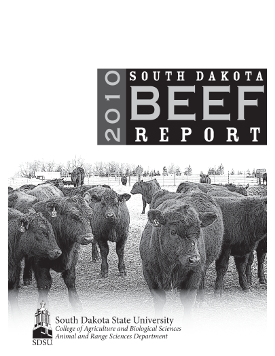Document Type
Report
Report Number
2010-4
Publication Date
2010
Summary
The objective of this research was to determine shifts in metabolism associated with differences in marbling relative to total fatness in beef carcasses. Dietary starch is thought to optimize accumulation of intramuscular adipose (IAT). The two mechanisms used to alter IAT accumulation were to substitute either readily fermentable fiber or corn oil for starch from corn. The model involved yearling steers (n = 144) during a 131 d finishing phase. The control diet contained 8.5% roughage and 81.2% corn. A higher fiber finishing diet included substitution of chopped, high moisture ear corn (43.7%) and dried corn gluten feed (18.2%) for corn. Corn germ was included to provide 0, 2, or 6% corn oil in both the starch and fiber diets. Carbohydrate source (CHO) affected (P < 0.05) apparent energy content of the diet. The higher fiber diet resulted in lower ADG, higher DMI, and lower gain/feed. This lowered hot carcass weight (HCW) from 832 to 801 lb (P < 0.01) but did not alter other measured carcass traits. The low level germ inclusion caused (P < 0.05) higher ADG and heavier HCW but reduced marbling (P < 0.05) and the ratio of marbling to total carcass fatness. Qualitative carcass traits were, in general, not affected (P >0.10) by the higher germ inclusion. A sub‐population of steers that were highest (n = 12) and lowest (n = 12) in marbling relative to total carcass fatness (M2Ratio) were scrutinized more closely to understand more about why marbling is or is not accumulated. Differences in M2Ratio were not associated with HCW or fatness, but were associated with marbling (P < 0.001). Serum collected early in the feeding period from high M2Ratio steers caused higher (P < 0.05) satellite cell proliferation and differentiation rates in vitro than serum from low M2Ratio steers. This response diminished with additional days on feed. These results indicate that dietary carbohydrate source has minimal influence on carcass fat distributions, but that dietary oil dramatically alters circulating metabolites and is antagonistic to the production goal of high marbling and high cutability carcasses
Number of Pages
7
Format
application/pdf
Language
en
Publisher
South Dakota State University
Rights
Copyright © 2010 South Dakota State University.
Recommended Citation
Pritchard, R.H.; Wertz-Lutz, A.; Bruns, K.W.; and Wulf, D.M., "Influence of Dietary Corn Oil on Production Efficiencies and Adipose and Muscle
Accretion in Beef Cattle" (2010). South Dakota Beef Report, 2010. 5.
https://openprairie.sdstate.edu/sd_beefreport_2010/5

